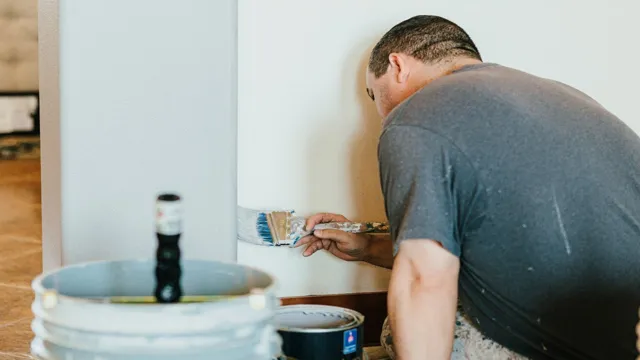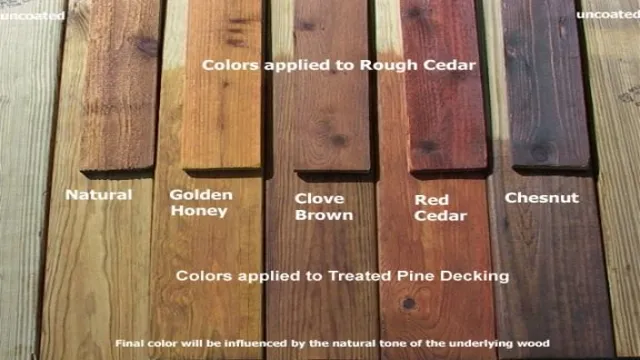Have you ever thought about bringing the beauty of interior wood stain to your outdoor projects? Using interior stain outside can be a great way to achieve a unique look and protect your wooden surfaces from the elements. However, before you start slathering on your favorite interior stain, there are a few things you need to know. In this blog, we will discuss the differences between interior and exterior stains, the pros and cons of using interior stain outside, and tips for successfully completing your staining project.
So, if you’re ready to enhance the look of your exterior space with interior stain, keep reading!
Understanding the Differences Between Interior and Exterior Stain
If you’re planning on staining wood for an outdoor project, it’s important to understand the differences between interior and exterior stain. While some people may be tempted to use interior stain outside, it’s not always the best idea. Interior stain is designed for use indoors and is not formulated to withstand the extreme weather conditions that can impact outdoor wood.
Exterior stain, on the other hand, is specifically designed to protect wood from moisture, UV rays, and temperature changes. It contains special chemicals and oils that help it to penetrate deep into the wood, providing long-lasting protection against the elements. Attempting to use interior stain outside could lead to fading, peeling, and other damage, as it’s not equipped to handle the harsh outdoor environment.
Therefore, it’s recommended that you use exterior stain for all outdoor staining projects to ensure that the wood remains protected and beautiful for years to come.
Different Functions of Interior and Exterior Stain
When it comes to stain, it’s important to understand the differences between interior and exterior stains. While both are designed to add color and protection to wood surfaces, they have varying functions. Interior stain is typically used for decorative purposes, enhancing the natural beauty of wood and adding depth and richness to its appearance.
It’s formulated with lower levels of oils and resins, making it easier to work with and resulting in a smoother finish. On the other hand, exterior stain is designed to protect wood from the elements, such as sunlight, moisture, and temperature changes. It’s formulated with higher levels of oils and resins, ensuring it’s durable and long-lasting.
By understanding the different functions of interior and exterior stain, you can choose the best stain for your specific project and achieve the desired results.

How Interior and Exterior Stain Differ in Composition
When it comes to adding color and protecting surfaces in our homes, staining is a popular choice. However, there is a key difference between interior and exterior stains in their composition. Interior stains are formulated with thinner solvents, while exterior stains contain thicker solvents and resins.
This is because exterior stains need to be able to withstand the elements and protect against UV rays and moisture. Interior stains are designed for indoor use and are not made to withstand harsh outdoor conditions. Exterior stains also often contain additives like mold and mildew inhibitors and color fastness to help them last longer in the sun.
Understanding the differences between interior and exterior stains can help you make the right choice for your project and ensure that your surfaces look their best for years to come.
The Risks of Using Interior Stain Outside
If you’re considering using interior stain outside, it’s important to understand the risks involved. While interior stain is designed to enhance the appearance of woodwork indoors, it’s not meant to withstand the elements found outside. Exterior wood is exposed to wind, rain, and sunlight, while interior wood is protected from these elements.
As a result, using interior stain outside can lead to peeling, fading, and cracking. Additionally, interior stain doesn’t provide the same level of protection against mold and mildew as exterior stains do. If you want to ensure the longevity and appearance of your outdoor woodwork, it’s best to choose a stain specifically designed for exterior use.
Don’t make the mistake of thinking that interior stain will be a cheaper alternative. In the long run, using the wrong type of stain could end up costing you more time and money in repairs. When it comes to exterior woodwork, it’s better to be safe than sorry.
Inability to Withstand Environmental Elements
Interior stain is not designed to withstand the harsh elements of the outside environment. When used outside, it can quickly deteriorate in appearance and lose its protective qualities. This means that the wood may become faded, discolored, and even damage over time.
Not only will this affect the overall appearance of the wood, but it can also compromise its structural integrity, making it more susceptible to rotting and warping. It’s important to use an exterior stain that is specifically formulated to withstand the elements if you want your wood to last. Interior stains should only be used on indoor projects, where they can provide the desired finish without being exposed to the harsh outdoor elements.
Don’t take chances with your project, choose an exterior stain that is specifically designed to withstand the elements, and get the most out of your wood.
Possible Fading and Discoloration
If you’re thinking about using interior stain outside, there are some risks that you should be aware of. One of the biggest risks is potential fading and discoloration. Interior stains are designed to be used in controlled environments and aren’t made to withstand the elements.
When exposed to the sun, wind, rain, and other outdoor conditions, interior stain can fade and lose its color. This can leave your project looking patchy and uneven, which is not what you want, especially if you have invested a lot of time and money into it. To avoid these issues, it’s best to use outdoor-specific stains that are designed to withstand the elements and keep your project looking great for longer.
Trust me- it’s worth it in the end.
Uneven Application and Blotchy Finish
One major risk of using an interior stain outside is uneven application and a blotchy finish. While interior stains are designed for use on interior surfaces, some people may be tempted to use them outdoors due to their availability or to save money. However, this is not a good idea as interior stains are not formulated to withstand exposure to the elements and can easily fade or peel.
Additionally, outdoor surfaces like decks and fences tend to have more varied textures and require specialized stain formulations to ensure even coverage. Using an interior stain on these surfaces can result in a patchy, uneven finish that looks unprofessional and can ultimately damage the wood. Therefore, it’s essential to use an outdoor stain specifically designed for external use to ensure a beautiful and long-lasting finish.
Alternatives to Using Interior Stain Outside
Can you use interior stain outside? While it may be tempting to use interior stain outside because of the convenience, it’s not advisable. Interior stain is designed for indoor use, and using it outside can result in problems such as peeling and fading. If you’re looking for alternatives to using interior stain outside, there are several options available.
One option is to use an exterior stain instead, which is designed to withstand the elements and provide long-lasting protection. Another option is to use a paint that is specifically designed for outdoor use, such as a waterproof, UV-resistant paint, which can give your project a unique and durable finish. Ultimately, it’s important to choose the right product for your project to ensure that your work looks its best and lasts as long as possible.
Exterior Stain Options
Exterior stains are a popular choice for homeowners looking to add a touch of color and protection to their outdoor living spaces. But what if you have some leftover interior stain and want to use it outside? While it may seem like a good idea, doing so can result in a number of issues. For instance, interior stain is not formulated to withstand the harsh elements, meaning it can fade, peel, or crack much quicker than its exterior counterparts.
Instead, consider alternatives such as water-based stains or oil-based stains specifically designed for outdoor use. Not only will they hold up better against the elements, but they also offer a wider variety of color options to choose from. So, the next time you’re debating whether to use interior stain outside, remember to opt for an exterior stain instead.
Paint as an Alternative Option
One alternative to using interior stain on outdoor surfaces is to use paint. While stain penetrates the wood to enhance its natural color and grain, paint forms a protective layer on top. This can be particularly useful for areas exposed to harsh weather conditions or high traffic, such as decks or fences.
Paint can also be more customizable in terms of color and finish, allowing for a wider range of design options. However, it’s important to choose a paint specifically formulated for outdoor use to ensure durability and prevent cracking or peeling. A high-quality primer can also help the paint adhere better to the surface and last longer.
Overall, using paint instead of stain can provide a more versatile and protective option for outdoor surfaces.
Conclusion: Stick to Exterior Stain for Outdoor Projects
In conclusion, while it may seem tempting to repurpose interior stain for an outdoor project, it’s important to remember that not all stains are created equal. Exterior stains are specially formulated to withstand the harsh elements of nature, whereas interior stains may not provide the same level of protection and durability. So, while it’s technically possible to use interior stain outside, it’s always better to err on the side of caution and make sure you’re using the right product for the job.
As the saying goes, “don’t bring a knife to a gunfight” – the same applies to staining your outdoor surfaces! Choose the right stain for the job and you’ll be sure to get the results you’re looking for.
FAQs
What happens if you use interior stain outside?
Interior stains are not designed to withstand the harsh outdoor elements and can result in the stain fading or peeling prematurely.
Can you use exterior stain inside?
Yes, you can use exterior stain inside as long as it is safe for indoor use. However, exterior stains tend to have a stronger odor and may take longer to dry.
Can you use deck stain on interior furniture?
Deck stain is not recommended for interior furniture as it is formulated to withstand outdoor conditions and can result in a sticky or tacky finish.
What is the difference between interior and exterior stain?
Interior stain is designed for use on indoor wood surfaces and is typically more resistant to wear and tear from foot traffic. Exterior stain is formulated to withstand harsh outdoor elements and protect against UV damage.
Can you use a water-based interior stain outside?
No, water-based interior stain is not recommended for outdoor use as it will not provide adequate protection against moisture and UV damage.
What type of exterior stain is best for a fence?
A semi-transparent or solid color stain is recommended for fences as they provide better protection against moisture and UV damage.
Can you use an exterior stain on an interior floor?
No, exterior stains are not recommended for interior floors as they may not be safe for indoor use and can result in an uneven or sticky finish.






